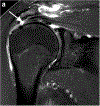Predictors of infraspinatus muscle degeneration in individuals with an isolated supraspinatus tendon tear
- PMID: 36195776
- PMCID: PMC10332804
- DOI: 10.1007/s00256-022-04201-7
Predictors of infraspinatus muscle degeneration in individuals with an isolated supraspinatus tendon tear
Abstract
Objective: Determine the demographic and clinical factors that predict infraspinatus muscle degeneration in individuals with an isolated supraspinatus tendon tear.
Materials and methods: A retrospective analysis was performed using the medical records of patients who had a shoulder MRI interpreted by 1 of 3 fellowship-trained musculoskeletal radiologists since the implementation of a standardized MRI 3 T protocol within our healthcare system. Demographic (e.g., age, sex) and clinical data (e.g., tear size, muscle degeneration, co-morbidities) were collected. Patients with an isolated supraspinatus tendon tear (n = 121) were assigned to one of two groups based on whether any infraspinatus muscle degeneration was present. Logistic regression was used to assess the univariate relationships between infraspinatus muscle degeneration and patient and clinical data, while least absolute shrinkage and selector operator (LASSO) logistic regression was used to assess the multivariable relationship.
Results: Of the patients with an isolated supraspinatus tendon tear, 16.5% had evidence of infraspinatus muscle degeneration. The presence of infraspinatus muscle degeneration was independently associated with cardiovascular disease (P = 0.01), supraspinatus muscle degeneration (P < 0.01), and subscapularis muscle degeneration (P = 0.01). When the multivariable relationship is assessed, supraspinatus muscle degeneration emerged as the only variable of significant importance for detecting infraspinatus muscle degeneration (specificity: 87.1%, sensitivity: 80.0%).
Conclusion: Infraspinatus muscle degeneration is not uncommon in individuals with an isolated supraspinatus tear and is most associated with concomitant supraspinatus muscle degeneration. These findings highlight the need for clinicians to specifically assess the status of each rotator cuff muscle, even when the tendon itself is intact.
Keywords: Infraspinatus muscle degeneration; MRI shoulder; Rotator cuff repair; Rotator cuff retear; Supraspinatus tendon tear.
© 2022. The Author(s), under exclusive licence to International Skeletal Society (ISS).
Conflict of interest statement
Figures



References
-
- Chung SW, Kim JY, Kim MH, Kim SH, Oh JH. Arthroscopic repair of massive rotator cuff tears: outcome and analysis of factors associated with healing failure or poor postoperative function. Am J Sports Med. 2013; 41(7):1674–1683. - PubMed
-
- Kluger R, Bock P, Mittlbock M, Krampla W, Engel A. Long-term survivorship of rotator cuff repairs using ultrasound and magnetic resonance imaging analysis. Am J Sports Med. 2011; 39(10):2071–2081. - PubMed
-
- Tashjian RZ, Hollins AM, Kim HM, Teefey SA, Middleton WD, Steger-May K, et al. Factors affecting healing rates after arthroscopic double-row rotator cuff repair. Am J Sports Med. 2010; 38(12):2435–2442. - PubMed
-
- Toussaint B, Schnaser E, Bosley J, Lefebvre Y, Gobezie R. Early structural and functional outcomes for arthroscopic double-row transosseous-equivalent rotator cuff repair. Am J Sports Med. 2011; 39(6):1217–1225. - PubMed
MeSH terms
Grants and funding
LinkOut - more resources
Full Text Sources
Medical

